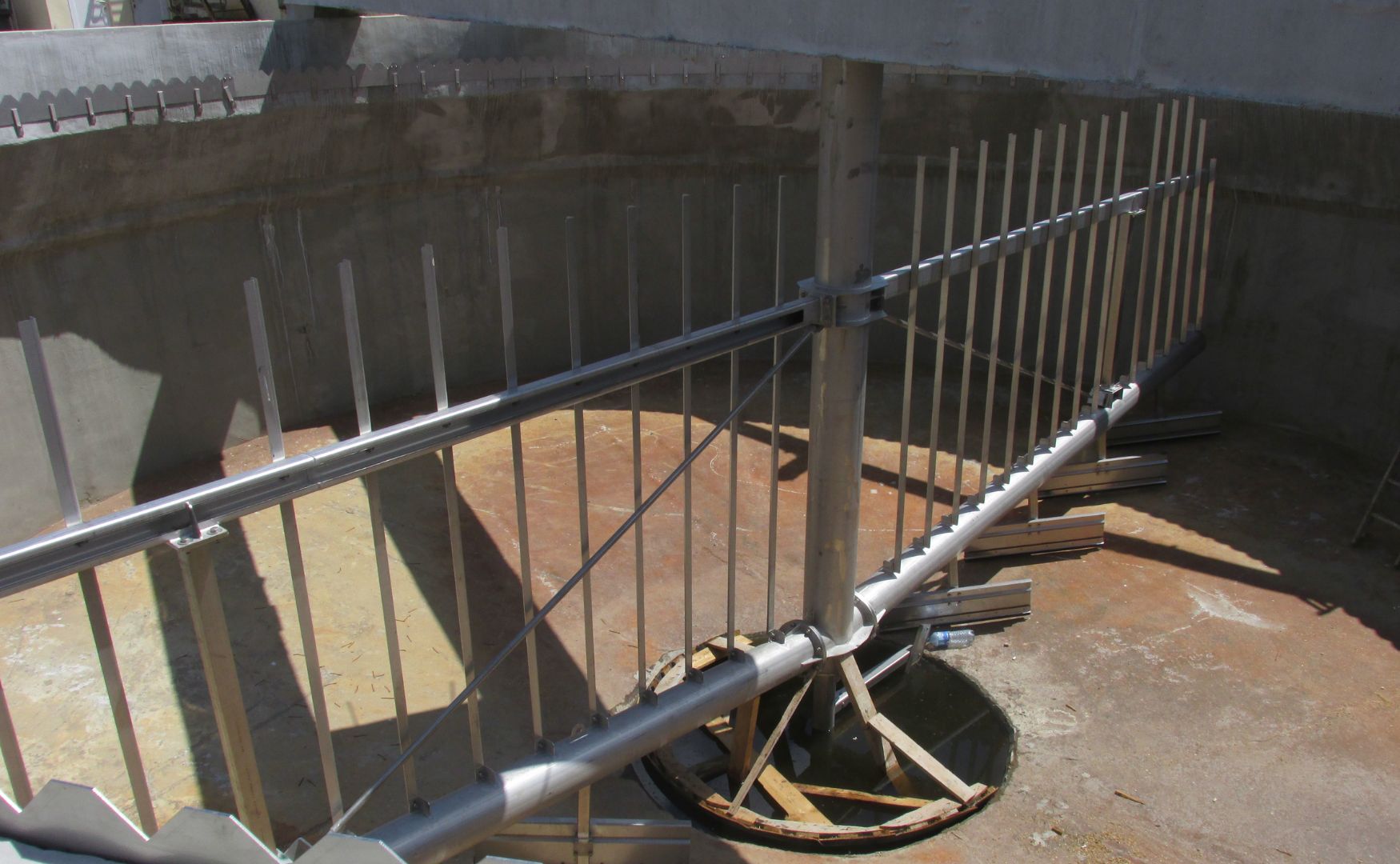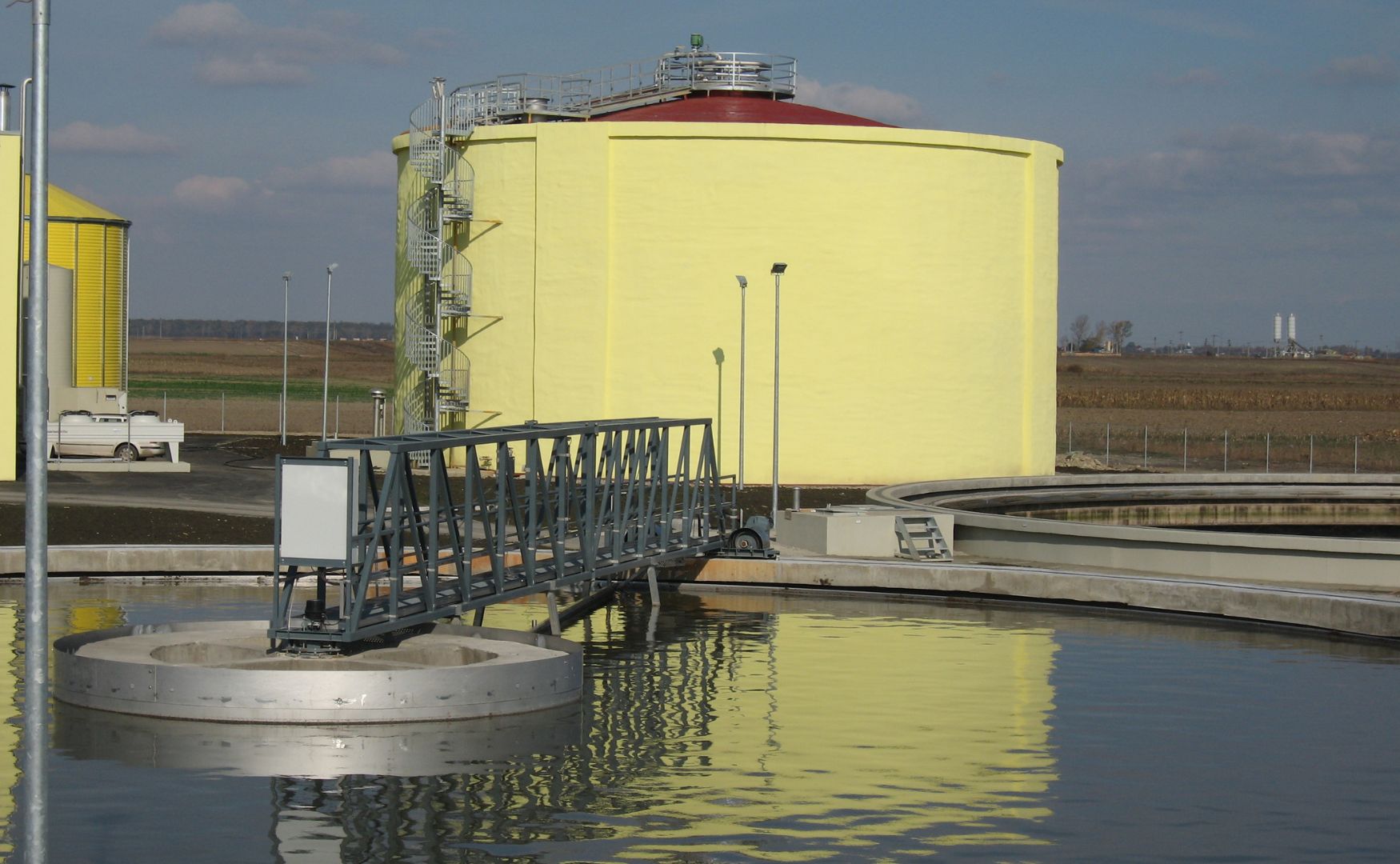A sedimentation tank is a technical device used to remove suspended solids and particles from water or wastewater. It works according to the physical principle of sedimentation, in which particles separate from the water due to gravity and settle at the bottom of the basin. Sedimentation tanks are an essential part of many water and wastewater treatment processes and are often used in mechanical pre-treatment, chemical-physical water treatment and biological wastewater treatment.
Table of contents
Meaning of sedimentation basin
Protection of downstream systems:
- Sedimentation tanks reduce the solids load in downstream treatment stages, such as biological reactors.
Increasing the efficiency of chemical-physical processes:
- The separation of precipitation products and flocs after treatment in CP plants is supported by sedimentation.
Wastewater treatment:
- In municipal and industrial wastewater treatment plants, sedimentation tanks are used to separate primary and secondary sludge and to produce clear water.
Conservation of resources:
- Recovery of solids, such as valuable metals or chemicals, from industrial wastewater.
How the sedimentation basin works
Sedimentation in the tank is based on the different densities of water and solids. Heavy particles sink under the effect of gravity, while lighter components, such as fats or oils, can float to the surface.
Types of sedimentation basins
The design and function of a sedimentation tank depend heavily on the respective application and the specific requirements. There are various types that are used in practice:
1. rectangular sedimentation basins
- Structure:
- Water flows horizontally through the basin.
- Sediments are collected at the bottom and removed by sludge scrapers.
- Application:
- Mechanical pre-treatment in wastewater treatment plants, separation of coarse suspended solids.
- Advantages:
- Simple construction and maintenance.
- Disadvantages:
- Relatively large space requirements.
2nd round sedimentation basin
- Structure:
- Water flows radially from the center to the periphery or vice versa.
- Sludge is collected and discharged centrally.
- Application:
- Often used as secondary clarifiers in municipal sewage treatment plants.
- Advantages:
- Compact design, even flow distribution.
- Disadvantages:
- More complex construction compared to rectangular pools.
3. lamella clarifier
- Structure:
- Pools equipped with inclined plates or tubes.
- Increased sedimentation surface due to the lamella structure.
- Application:
- High separation efficiency with small size, especially in industrial applications.
- Advantages:
- Space-saving, high efficiency.
- Disadvantages:
- Higher maintenance costs due to the slat structures.
4. primary and secondary clarifiers
- Primary clarifier:
- Removes coarse particles before biological treatment.
- Secondary clarifier:
- Separates the activated sludge from the treated wastewater after biological treatment.

Photo: Our secondary clarifier with circular scraper as part of our ALMA BHU BIO biological treatment plant
Important design parameters
Hydraulic load:
- The inflow should be regulated in such a way that no turbulence occurs that could impair sedimentation.
- Typical flow velocity: 0.3-0.5 m/s.
Dwell time:
- The retention time in the tank depends on the particle size and the sedimentation properties.
- Typical: 1-2 hours.
Surface load:
- Ratio between flow rate and basin surface area, specified in m3/m2⋅h (volume flow per surface area).
- Typical values: 0.5-2 m³/m²-h.
Sludge removal:
- Regular removal of settled sludge is necessary to keep operation efficient and prevent re-suspension of particles.
Separation efficiency:
- The aim is to separate at least 90 % of the particles with a size > 0.1 mm.
Factors that influence efficiency
Water composition:
- Particle density, viscosity and temperature of the water have a direct influence on sedimentation.
Hydraulic conditions:
- Turbulence and short-circuit flows reduce the separation efficiency.
Additives:
- The addition of flocculants (e.g. polymers, aluminum salts) improves the separation of fine particles.
Maintenance:
- Deposits or siltation in the pool floor reduce the effectiveness and increase the risk of malfunctions.
Practical applications
1. water treatment
- In river water treatment, sedimentation tanks are used to remove sand, silt and organic matter before the water is treated further.
2. wastewater treatment
- In municipal wastewater treatment plants:
- Pre-treatment: Removal of sand, grease and coarse particles.
- Secondary clarification: Separation of activated sludge after biological treatment.
- In industrial wastewater systems:
- Separation of solids from production wastewater (e.g. in the food industry, metalworking).
3. precipitation and flocculation in CP plants
- Sedimentation tanks are used to separate precipitated substances such as phosphates, heavy metals or organic particles.

Photo: Sedimentation tank with recirculation of biomass in our anaerobic bioreactor ALMA BHU GMR
Advantages of sedimentation basins
Energy efficiency:
- No mechanical conveying required as sedimentation is based on gravity.
Robustness:
- Suitable for a wide range of particles and wastewater.
Scalability:
- Can be adapted to different flow rates and applications.
Challenges and opportunities for optimization
Efficiency with finer particles:
- Very fine or colloidal particles sediment only slowly. Pre-treatment by precipitation or flotation can improve efficiency.
Space requirement:
- Traditional sedimentation tanks require a lot of space. The use of lamella clarifiers or compact systems can minimize this.
Sludge disposal:
- The sludge deposited on the floor must be removed regularly and disposed of or treated properly.
Conclusion
Sedimentation tanks are indispensable components of water and wastewater technology that impress with their robust and energy-efficient design. Their versatile applications range from mechanical pre-treatment to precipitation and flocculation in CP systems and biological treatment. Careful planning, regular maintenance and optimization of the operating parameters are essential to ensure high separation efficiency and maximize the service life of the systems. Modern developments such as lamella clarifiers and automated sludge removal systems are continuously improving the efficiency of sedimentation tanks, further increasing their relevance in industrial and municipal water treatment.
For further information on our products, please feel free to contact us at any time!








